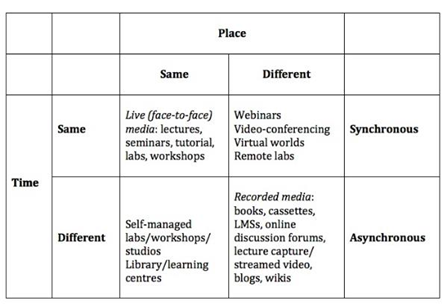8. The Time and Space Dimensions of Media
8.2. Synchronous or Asynchronous
Synchronous technologies require all those participating in the communication to participate together, at the same time, but not necessarily in the same place.
Thus live events are one example of synchronous media, but unlike live events, technology enables synchronous learning without everyone having to be in the same place, although everyone does have to participate in the event at the same time. A video-conference or a webinar are examples of synchronous technologies which may be broadcast ‘live’, but not with everyone in the same place. Other synchronous technologies are television or radio broadcasts. You have to be ‘there’ at the time of transmission, or you miss them. However, the ‘there’ may be somewhere different from where the teacher is.
Asynchronous technologies enable participants to access information or communicate at different points of time, usually at the time and place of choice of the participant. All recorded media are asynchronous. Books, DVDs, on-demand YouTube videos, lectures recorded through lecture capture, and available for streaming on-demand, and online discussion forums are all asynchronous media or technologies. Learners can log on or access these technologies at times and the place of their own choosing.
Figure 11 illustrates the main differences between media in terms of different combinations of time and place.

